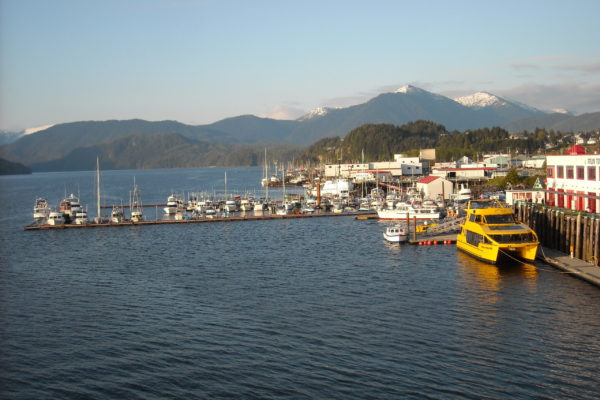
Background information
Prince Rupert is located in the traditional territory of the Tsimshian Nation. The Tsimshian have inhabited the region for over 10 000 years. Other Tsimshian villages in the territory include Metlakatla, Lax Kw’alaams (Port Simpson), Metlakatla Alaska, Kikatla, Hartley Bay (Gitga’ata), Klemtu, Kitselas and Kitsumkalum. Estimates suggest that up to 10 000 Tsimshian may have inhabited villages in the region prior to European contact.
Prince Rupert is located on Kaien Island. “Kaien” is a Tsimshian word that refers to sea foam, such as the foam found at Zanardi Rapids on the south side of the island after heavy rains. Tsimshian and Haida peoples used to meet on island.
Settler arrival
In 1834, the Hudson’s Bay company established Fort Simpson (later named Port Simpson) to deter Russian activity in the region during the fur trade. Nine Tsimshian villages moved within close proximity to Fort Simpson for the purposes of trade, and Kaien Island became a less frequently visited location. Port Simpson is now called Lax-Kw’alaams, and is located 40 km north of Prince Rupert.
In 1874, the first Methodist missionary arrived in Lax Kw’alaams, named Thomas Crosby. Crosby’s wife Emma Crosby established the Crosby Girls Home in 1879. In 1893, the home was run as part of the Indian residential school system in B.C. It was operated by the Women’s Missionary Society up until 1925, and then operated by the United Church of Canada until its closure in 1948. The Crosby Boys’ home was founded in 1890 and remained open until 1914.
Grand Trunk Pacific Railway
In 1903, the Canadian government approved construction of the Grand Trunk Pacific Railway. The railway was initially to run from Winnipeg, Manitoba through to Melville, Saskatchewan, then to Edmonton, Alberta and on to Port Simpson. However, the B.C.-Alaska border had not yet been firmly established, and U.S. president Theodore Roosevelt threatened to deploy troops to Alaska to defend the U.S. position. Canadian Prime Minister Wilfred Laurier chose to move the end of the railway further south to ease tensions, and Kaien Island became the new end of the line for the Grand Trunk Pacific Railway.
The island was named in 1892, when Prince Rupert Harbour was first surveyed. The railway company held a contest in 1906 to name the line’s final destination, with a grand prize of $250 to the winner. Twelve thousand people entered the contest. Officials running the contest preferred “Prince Rupert,” named after the first governor of the Hudson’s Bay Company. However, contest rules limited suggestions to names no longer than ten characters, with Prince Rupert being twelve. Out of fairness, two other entrants, both of whom suggested the ten-character “Port Rupert,” were also awarded prize money.
The Grand Trunk Pacific Railway purchased the 5666 hectare First Nations reserve on the island and received an additional 4047 hectare land grand from the Canadian government. A post office was located on the premises in November, 1906. The town of Prince Rupert was officially incorporated in 1910, and was relatively well established by that time.
In 1919, the Canadian government acquired the Grand Trunk Pacific Railway as well as the Grand Trunk Railway, which operated further east in Ontario and Quebec. In 1923, these two railways merged with National Transcontinental to become the Canadian Northern Railway Company.
The Kwinitsa Railway Station was built in 1912 as part of the Grand Trunk Pacific Railway. The station remains intact and is preserved as the Kwinista Railway Museum.
Canneries
In nearby Port Edward, the North Pacific Cannery operated from 1889-1968. In 1985, the cannery was designated a National Historic Site.
In 1940, Nelson Brothers Fisheries built the Oceanside Cannery on the Prince Rupert waterfront. From 1942-1950, the cannery was used by U.S. military forces for shipbuilding and as a stopover for troops and materials destined for Alaska, the Pacific Islands and East Asia.
In 1951, the Canadian Fishing Company reopened the cannery. A dock fire destroyed the cannery in 1972. The company built a new Oceanside Cannery in time for the 1973 season. The new cannery was able to freeze sixty thousand cases of salmon in one day. Its cold-storage area could hold up to 453 592 kg (1 000 000 pounds) of fish. The cannery was able to produce four to five hundred thousand cases of canned salmon annually.
The new Oceanside Cannery closed in 2015. It was the last industrial-scale cannery to operate in British Columbia.
Industry
In 1972, the port of Prince Rupert was designated a national port. In 1997, governance of the port was assigned to the Prince Rupert Port Authority. Many products are shipped from Prince Rupert by boat, including grain, lumber, pulp, and mineral ore.
Coal mined in NE B.C. was shipped from nearby Ridley Island during the early 1980s, but the coal mines closed in 2001.
After the war, a pulp mill was established on nearby Watson Island. The pulp mill closed in 2001.
BC Ferries and Alaskan ferries both include stopovers in Prince Rupert, as well as cruise ships.
Chartered fishing expeditions are a popular tourist activity in Prince Rupert.
In 2020. the Prince Rupert Port Authority proposed a port expansion on Ridley Island, to be called the Ridley Island Export Logistics Park. The federal government approved the proposal, which is expected to double the cargo capacity of the port by 2040.
Prince Rupert is an important starting point for many tours offered throughout the Great Bear Rainforest region. BC Ferries offers sailings from Prince Rupert to:
Additionally, BC Ferries offers sailings from Prince Rupert to the nearby Haida Gwaii (formerly known as the Queen Charlotte Islands).
Getting to Prince Rupert
Train
Train service is available from Prince George to Prince Rupert. Prince Rupert is situated within the Great Bear Rainforest region, while Terrace is located nearby, less than two hours away by car.
Plane
The Prince Rupert airport is located on Digby Island, nine km away from Prince Rupert. The Digby Island Ferry provides passengers with transport from the airport to the city. Air Canada offers flights to Prince Rupert from many major Canadian cities.
Automobile
From Prince George, you can drive eight hours (718 km/446 mi) to Prince Rupert on the TransCanada Yellowhead Highway 16.
Boat
BC Ferries offers sailings to Prince Rupert from
- Bella Bella
- Bella Coola
- Klemtu
- Ocean Falls
- Port Hardy
- Shearwater
Tour operators
Bluewater Adventures
https://www.bluewateradventures.ca/adventures/great-bear-rainforest.html
Inland Air Charters Ltd.
http://inlandair.bc.ca/
Kwinista Railway Museum
https://www.museumofnorthernbc.com/exhibits/kwinitsa-railway-museum/
Maple Leaf Adventures
https://mapleleafadventures.com/interests/great-bear-rainforest-lodging/?gclid=EAIaIQobChMIxeD-tJD27AIVFB-tBh0VcA5DEAMYAiAAEgIxL_D_BwE
Ocean Adventures
https://www.oceanadventures.bc.ca
Outer Coast Outfitters
http://outercoast.ca/
Pacific Tugboat Adventures
https://www.tugboatcruise.com
Prince Rupert Adventure Tours
https://www.adventuretours.ca
Additional information
Museum of Northern BC
https://www.museumofnorthernbc.com
North Pacific Cannery
https://www.northpacificcannery.ca
Prince Rupert (British Columbia.com)
https://britishcolumbia.com/plan-your-trip/regions-and-towns/northern-bc-and-haida-gwaii/prince-rupert/
Welcome to Prince Rupert
https://visitprincerupert.com
Explore more Communities found in the Great Bear Rainforest.

